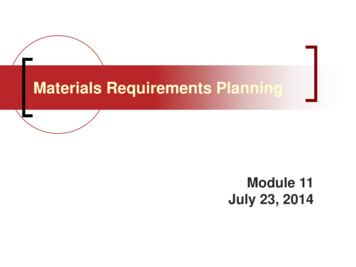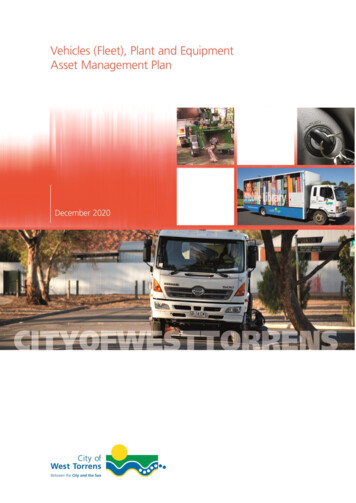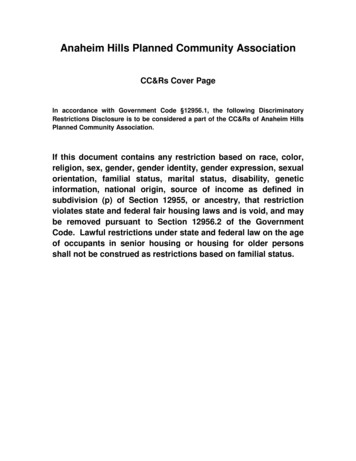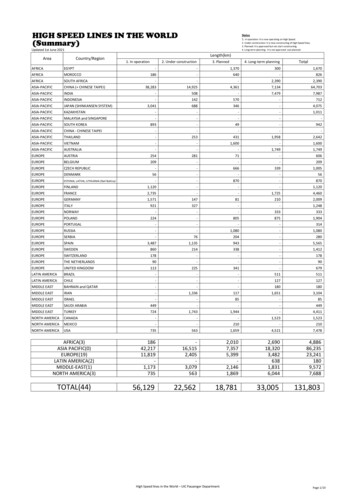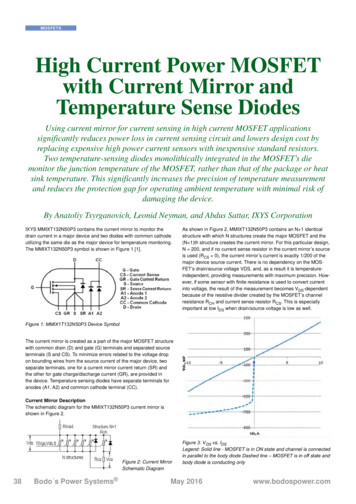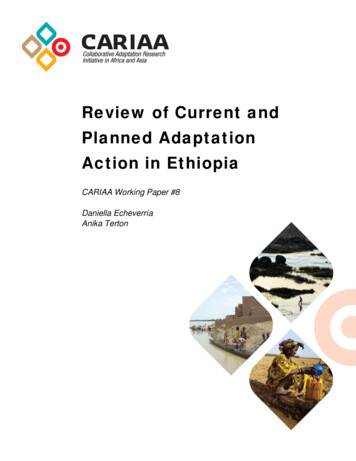
Transcription
Review of Current andPlanned AdaptationAction in EthiopiaCARIAA Working Paper #8Daniella EcheverríaAnika Terton
CARIAA Working Paper #8Echeverria, D and Terton, A. 2016. Review of current and planned adaptation action in Ethiopia.CARIAA Working Paper no. 8. International Development Research Centre, Ottawa, Canada andUK Aid, London, United Kingdom. Available online at: www.idrc.ca/cariaaISSN: 2292-6798This CARIAA working paper has been prepared by the International Institute for SustainableDevelopment (IISD).About CARIAA Working PapersThis series is based on work funded by Canada’s International Development Research Centre(IDRC) and the UK’s Department for International Development (DFID) through theCollaborative Adaptation Research Initiative in Africa and Asia (CARIAA). CARIAA aims tobuild the resilience of vulnerable populations and their livelihoods in three climate change hotspots in Africa and Asia. The program supports collaborative research to inform adaptation policyand practice.Titles in this series are intended to share initial findings and lessons from research andbackground studies commissioned by the program. Papers are intended to foster exchange anddialogue within science and policy circles concerned with climate change adaptation invulnerability hotspots. As an interim output of the CARIAA program, they have not undergone anexternal review process. Opinions stated are those of the author(s) and do not necessarily reflectthe policies or opinions of IDRC, DFID, or partners. Feedback is welcomed as a means tostrengthen these works: some may later be revised for peer-reviewed publication.ContactCollaborative Adaptation Research Initiative in Africa and Asiac/o International Development Research CentrePO Box 8500, Ottawa, ONCanada K1G 3H9Tel: ( 1) 613-236-6163; Email: cariaa@idrc.caCreative Commons LicenseThis Working Paper is licensed under a Creative Commons Attribution-NonCommercialShareAlike 4.0 International License. Articles appearing in this publication may be freely quotedand reproduced provided that i) the source is acknowledged, ii) the material is not used forcommercial purposes, and iii) any adaptations of the material are distributed under the samelicense. 2016 International Development Research CentreCover photos:Top: PANOS/Jean-Leo DugastBottom: PANOS/Abbie Trayler-SmithLeft: Blane Harvey
CARIAA Working Paper #8AbstractIn Ethiopia, climate variability and change, including rising temperatures and increasingrainfall variability, challenge the country’s efforts to realize its vision of inclusion andprosperity. Ethiopia is among the countries that are most vulnerable to climate change inEast Africa, and this process is expected to negatively impact progress in sectors such asagriculture, transportation, energy, and health. Ethiopia’s pastoral and agro-pastoralcommunities, as well as smallholder farmers, are particularly vulnerable to climate change,and will require a concerted focus on adaptation to reduce poverty and build resilience. TheGovernment of Ethiopia has made efforts to recognize climate change as a risk in sectoralpolicies on agriculture, health, and energy. The majority of national and internationalprogramming efforts concentrate on the agricultural sector, including pastoralism, as wellas disaster risk management and capacity building for government officials and civil society.The country’s Growth and Transformation Plan, Programme of Adaptation to ClimateChange, and Climate Resilient Green Economy Strategy are key national roadmaps thatguide these efforts. However, there are gaps in adaptation action addressing vulnerabilitiesin specific sectors, notably health, transportation, and energy. This report provides asnapshot of adaptation action in Ethiopia and is one in a series of country reviews preparedin support of the Collaborative Adaptation Research Initiative in Africa and Asia.iii
CARIAA Working Paper #8RésuméExamen des mesures d’adaptation actuelles et prévues en ÉthiopieEn Éthiopie, la variabilité du climat, notamment la hausse des températures etl’augmentation de la variabilité des précipitations, complique les efforts du pays visant àréaliser sa vision en matière d’inclusion et de prospérité. L’Éthiopie fait partie des pays lesplus vulnérables d’Afrique de l’Est à l’égard des changements climatiques. On s’attend à ceque ce processus nuise aux progrès dans des secteurs comme l’agriculture, le transport,l’énergie et la santé. Les communautés pastorales et agro pastorales d’Éthiopie ainsi que lespetits exploitants agricoles sont particulièrement vulnérables aux changements climatiques: des efforts concertés d’adaptation pour réduire la pauvreté et favoriser la résiliencedevront donc être déployés. Le gouvernement éthiopien s’efforce de reconnaître leschangements climatiques comme un risque dans les politiques sectorielles en matièred’agriculture, de santé et d’énergie. La plupart des programmes nationaux et internationauxsont axés sur le secteur agricole, qui comprend le pastoralisme, ainsi que sur la gestion desrisques de catastrophe et sur le renforcement des capacités des responsablesgouvernementaux et de la société civile. Le plan de croissance et de transformation du pays,ainsi que son programme d’adaptation aux changements climatiques et sa stratégied’économie verte et résiliente à l’égard du climat sont des feuilles de route nationalesessentielles pour orienter ces efforts. Cependant, il existe des lacunes en matière demesures d’adaptation aux vulnérabilités dans des secteurs précis, comme la santé, letransport et l’énergie. Ce rapport fournit un aperçu des mesures d’adaptation en Éthiopie etfait partie d’une série d’examens des pays préparés dans le cadre de l’Initiative de rechercheconcertée sur l’adaptation en Afrique et en Asie.iv
CARIAA Working Paper #8AcronymsACCRAAfrica Climate Change Resilience AllianceCARIAACollaborative Adaptation Research Initiative in Africa and AsiaBRACEDCDKNBuilding Resilience and Adaptation to Climate Extremes and DisastersClimate & Development Knowledge NetworkCIACentral Intelligence AgencyDFATDDepartment of Foreign Affairs, Trade and Development [Canada]CRGEDFIDENSOEPAEPACCFDREGDPClimate Resilient Green EconomyDepartment for International Development [United Kingdom]El Niño Southern OscillationEnvironmental Protection AuthorityEthiopia’s Programme of Adaptation on Climate ChangeFederal Democratic Republic of EthiopiaGross Domestic ProductGIZDeutsche Gesellschaft für Internationale ZusammenarbeitHSDP-IVHealth Sector Development Programme IVGTPIDRCIPCCIPMMGrowth and Transformation PlanInternational Development Research CentreIntergovernmental Panel on Climate ChangeInternational Partnership on Mitigation and Monitoring, Reporting, andVerification (MRV)ITCZInter-Tropical Convergence ZoneMoAMinistry of AgricultureMDGMoFEDMoHMillennium Development GoalMinistry of Finance and Economic DevelopmentMinistry of Healthv
CARIAA Working Paper #8MoWEMinistry of Water and EnergyNAPANational Adaptation Programme of ActionMoWRNORADNORHEDNPCOECDORDAPIFSDCMinistry of Water ResourcesNorwegian Agency for Development CooperationNorwegian Programme for Capacity Development in Higher Education andResearch for DevelopmentNational Planning CommissionOrganisation for Economic Co-operation and DevelopmentOrganization for Rehabilitation and DevelopmentEthiopia’s Agricultural Sector Policy and Investment FrameworkSwiss Agency for Development and CooperationSNNPRSouthern Nations, Nationalities, and Peoples’ RegionUNDPUnited Nations Development ProgrammeUKAIDUNEPUNFCCCUSAIDUnited Kingdom Agency for International DevelopmentUnited Nations Environment ProgrammeUnited Nations Framework Convention on Climate ChangeUnited States Agency for International Developmenvi
CARIAA Working Paper #8About the authorsDaniella EcheverríaProject Officer, International Institute for Sustainable DevelopmentWinnipeg, CanadaDaniella Echeverría is a researcher with the CARIAA-supported review of current andplanned adaptation in the CARIAA program’s countries of focus. Her work focuses onbuilding capacity to manage climate risks through knowledge sharing, the use of decisionsupport tools, and policy analysis focused on the green economy and food security.Contact: decheverria@iisd.caAnika TertonProject Officer, International Institute for Sustainable DevelopmentWinnipeg, CanadaAnika Terton is a researcher with the CARIAA-supported review of current and plannedadaptation in the CARIAA program’s countries of focus. She undertakes research in areassuch as transitioning to the green economy, achieving the Sustainable Development Goals,and building climate resilience in the Canadian Prairies and internationally.Contact: aterton@iisd.cavii
CARIAA Working Paper #8AcknowledgementsThe authors would like to thank Angie Dazé for insights and contributions to the content ofthis report, and Jo-Ellen Parry for her guidance and advice on its preparation.viii
CARIAA Working Paper #8ContentsAbstract. iiiRésumé. ivSynopsis . xIntroduction . 11.Current climate and projected changes . 21.1 Current climate . 31.2 Observed climate trends . 42.1.3 Climate projections . 5Vulnerability to climate change . 62.1 Current drivers of vulnerability. 62.2 Vulnerability of key sectors . 103.2.3 Vulnerable regions and groups . 13Adaptation planning context . 143.1 National-level development policy context . 153.2 National-level climate policy context . 163.3 Institutional structure for climate governance . 203.4 National-level sectoral policies . 214.5.6.7.8.3.5 Subnational policies . 25Current and planned adaptation programs and projects . 264.1 Adaptation projects and programs. 264.2 Climate finance . 30Networks and communities of practice . 32Conclusions . 33Annexes . 35References . 59ix
CARIAA Working Paper #8Synopsis1Climaterisks Soil degradation anderosion Increasing temperaturesVulnerablesectorsPotential impacts on vulnerable sectorPriority adaptation measures in each sectorAgriculture Increased incidence of fires, droughts, andfloods Decreased water availability Loss of crop production Increased environmental degradation Increased soil erosion Changes in agricultural calendar Increased incidence of pests and diseases Reduce impacts of severe drought by cloud seeding to induce rainStore food and animal feed in good years for use in bad yearsIdentify and prevent worsening of existing and emergence of new animal diseasesIdentify and prevent worsening of existing and emergence of new crop andwildland plant diseases and pests Counter the agricultural productivity reduction that emanates from climatechange through effective research and development60%Water Decreased water flow Increased incidence of floods and drought Manage water effectively to make it always available to humans, animals, andcrops Reduce the impacts of severe droughts by cloud seeding to induce rain13%Energy Interruption and reduction in hydropowergeneration Damages to energy infrastructure Shift homesteads to using renewable energy resources Shift from fossil fuels to renewable energy for running engines for transportationand other purposes0%Roadnetwork Road washouts Higher maintenance and recovery costs Disruption in transportation and relatedservicesHealth Increased incidence of water-, air-, andvector-borne diseases Increasing rainfallvariability Increased intensity ofdroughtKey sources ofvulnerability Reliance on crop production and pastoralism for livelihoods High food insecurity Challenges in sustainable management of land and waterresourcesProjectsinsector 10% Identify and prevent worsening of existing and the emergence of new humandiseases3%Percentage of total identified discrete adaptation projects and programs based on research undertaken as part of this review. Note that individual projects may address more than one sector.x
CARIAA Working Paper #8 Increased expenditure in health care Damages to health infrastructure Interruption in health services Create a nationwide health extension program on preventive health care at thehousehold level Identify high-risk woredas (districts) based on prevalence and recurrence ofvector-borne diseases Emphasise the needs of vulnerable groups (women, the marginalized, thedisabled, the elderly, and children) Increase the number of healthcare workersParticularly vulnerable regionsParticularly vulnerable groupsStatus of climate governance (policies, institutions) Arid and semi-arid areas Individuals living in drought- and flood-proneareas Poor women in rural areas Pastoral communities Smallholder rain-fed farmers Climate change recognized in country’s guiding developmentvision/plan National-level coordinating entity for climate change establishedand active Climate change policy and/or law in place Climate change action plan published Adaptation plan published Climate Change Fund operational Climate change units established in key ministries Climate change integrated into national sectoral policiesxi
CARIAA Working Paper #8IntroductionEthiopia is a landlocked East African country that shares borders with Eritrea to the northand northeast, Djibouti and Somalia to the east, Sudan and South Sudan to the west, andKenya to the south (see Figure 1). The country has achieved significant economic growthover the past decade, resulting in its becoming one of the top-performing countries on thecontinent in terms of economic development. Despite this progress, rates of multidimensional poverty remain high, and an estimated 7 million Ethiopians are chronicallyfood insecure (Zerihun, Kibret, & di Falco, 2014), predominantly in pastoral and farmingcommunities in drought-prone areas (FDRE, 2013a).The country seeks to achieve middle-income-country status by 2025 but needs to overcomevarious hurdles to do so, including the country’s high vulnerability to climate change.Ethiopia’s climate is highly variable, both spatially and temporally, and projections suggestthat this variability will continue alongside rising temperatures. This has significantimplications for efforts to reduce poverty and food insecurity, particularly for women,people living in drought- and flood-prone areas, and those who are dependent on cropproduction and pastoralism for their livelihoods. To address these challenges, and toachieve economic growth and prosperity, the country will need to reduce vulnerability inkey sectors such as agriculture, water, and health, while also improving the adaptivecapacity of poor individuals and communities. Through the introduction of its ClimateResilient Green Economy (CRGE) Strategy and efforts to integrate climate change into thenational development strategy, Ethiopia has demonstrated strong political will to addressclimate change and its impacts through adaptation and mitigation measures.This paper provides a snapshot of current and planned efforts in Ethiopia to advance actionat the local, subnational, and national levels to adapt to the impacts of climate change.Drawing upon available literature, it has been prepared to support the contribution of theCollaborative Adaptation Research Initiative in Africa and Asia (CARIAA) to adaptationpolicy and practice. CARIAA is jointly funded by the United Kingdom’s Department forInternational Development (DFID) and the International Development Research Centre(IDRC), with the aim of building the resilience of vulnerable peoples and their livelihoods inthree “hot spots” of climate change vulnerability in Africa and Asia: semi-arid areas, deltasin Africa and South Asia, and glacier- and snow-fed river basins in the Himalayas. To achievethis goal CARIAA is supporting four consortia to conduct high-calibre research and policyengagement activities that will inform national and subnational planning processes in 17countries.This report is one in a series of country reviews prepared to provide CARIAA with a pictureof the policies, programs, and projects designed and implemented specifically to address thecurrent and projected impacts of climate change in its countries of engagement. It begins byproviding an overview of the current and projected climate risk context in Ethiopia,followed by a discussion of the factors that contribute to its vulnerability to climate change1
CARIAA Working Paper #8and of its most vulnerable sectors, regions, and groups. A review of the critical policies andplans shaping Ethiopia’s efforts to address climate change adaptation at the national andsubnational levels is then provided. To assess the extent to which efforts are presentlyunderway to address the country’s critical adaptation priorities, section 5 paints a generalpicture of the scale, type, and focus of current adaptation-focused programs and projects inEthiopia, as well as the level of climate finance flowing into the country to support thiswork. A profile of in-country efforts to advance adaptation learning and knowledge sharingis then provided in section 6 through the identification of networks and communities ofpractice active in this field. The paper concludes with an assessment of the general status ofadaptation action at the national and subnational levels.Figure 1 – Map of EthiopiaSource: University of Texas Libraries, University of Texas at Austin, n.d.1. Current climate and projected changesThis section provides an overview of the climate risk context in Ethiopia, beginning with ageneral description of the country’s current climate and eco-climatic zones. This descriptionis followed by a discussion of observed trends and projected changes to its climate over theremainder of this century.2
CARIAA Working Paper #81.1 Current climateEthiopia’s climate is strongly influenced by its topography. It is a mountainous countrycovering over 1,104,300 square kilometres (CIA, 2015), with 45% of its land mass made upof high plateaus with mountain ranges divided by the East African Rift Valley. The majorityof the population is concentrated in highland regions with elevations greater than 1,500meters above sea level. The lowlands are more sparsely populated, mainly with nomadicand semi-nomadic pastoralist communities (World Bank, 2010a). Ethiopia’s drylands arelocated in the south, east, and north of the country, with arid and semi-arid regions covering63% of the territory (Few et al., 2015). Ethiopia has eight main climatic zones at differentaltitudes, ranging from warm and semi-arid to cold and moist, as shown in Table 1. Meanannual temperatures are around 15 C to 20 C in the highlands, while the lowlandsexperience average temperatures of 25 C to 30 C (World Bank, 2010a).Table 1 – Ethiopia’s climatic zonesZoneAltitude (m)Mean rainfall(mm)Temperature( C)Bereha (dry-hot)500–1,500 900 22Weinadega (dry-warm)1,500–2,500 90018–20Erteb Kola ega b Weinadega (moistcool)1,500–2,500 1,00018–20Dega (cold)2,500–3,500900–1,00014–18Erteb dega (moist-cold)2,500–3,500 1,00010–14Wurch (very cold or alpine) 3,500 1,000 10Source: Mengistu, n.d.The Inter-Tropical Convergence Zone (ITCZ) influences Ethiopia’s seasonal patterns as itoscillates from northern Ethiopia during the months of July and August to its position southof Kenya in January and February (McSweeney et al., 2010a). Between mid-June and midSeptember, as the ITCZ is at its most northern point, most of Ethiopia experiences the mainrainy season, Kiremt, receiving up to 350 mm of rainfall per month (Few et al., 2015;McSweeney et al., 2010a). In parts of northern and central Ethiopia, a second wet season,known as Belg, occurs between February and May. Rainfall during the Belg season is lowerand more sporadic than during the Kiremt rains. In the southern parts of Ethiopia, the rainsare influenced by the southward migration of the ITCZ (McSweeney et al., 2010a). In theseregions, the Belg is the main rainy season, occurring between March and May and yielding100 mm to 200 mm of rainfall per month. A second, less significant wet season, known as3
CARIAA Working Paper #8the Bega, occurs between October and December, with an average of 100 mm of rainfall permonth. Ethiopia’s easternmost corner receives very little rain (Few et al., 2015; McSweeneyet al., 2010a).The sea-surface temperatures of the Indian Ocean are another element influencing EastAfrica’s climate (Daron, 2014), causing a reduction in onshore moisture travel whileincreasing continental atmospheric stability (Funk et al., 2008). This affects the start andlength of rainy seasons in Ethiopia, and varies considerably on an interannual basis, causingfrequent drought (McSweeney et al., 2010a). Ethiopia’s climate is also influenced by the ElNiño Southern Oscillation (ENSO). However, to date, the factors that link ENSO and EastAfrica’s climate are yet to be fully understood (Daron, 2014). The warm El Niño phase isassociated with a reduction in rainfall during Kiremt in northern and central Ethiopia, whichhistorically has been associated with severe drought and famine. On the other hand,enhanced rainfall typically occurs in El Niño years in the earlier February to April rainyseason, mostly affecting southern Ethiopia (McSweeney et al., 2010a). The La Niña phase,which occurs when the ocean surface is cooler than average, is associated with drier thannormal conditions (Daron, 2014). The various factors influencing Ethiopia’s climate resultin considerable seasonal and annual variability. This creates high uncertainty in Ethiopia’srainfall patterns and higher risk of extreme climate events such as droughts and floods(Conway & Schipper, 2011).1.2 Observed climate trendsA temperature increase of 1.3 C between 1960 and 2006 has been observed in Ethiopia,representing an average change of 0.28 C per decade. In the same period of observation, theperiod of July to September had the fastest warming rate of 0.32 C per decade. The upwardtemperature trend has been evident as well in an estimated 20% increase in the averagenumber of hot days (73 days), with June to August having the highest increase, at 32% (9.9days per month). On the other hand, the number of cold days has decreased in all seasons,with the exception of December to February, while the frequency of cold nights hasdecreased more rapidly and significantly in all seasons (McSweeney et al., 2010a).In terms of precipitation, some studies note no statistically significant trend in mean rainfallin any season due to the large interannual and interdecadal variability in Ethiopia’s rainfall(Conway & Schipper, 2011; McSweeney et al., 2010a). Daron (2014), on the other hand,notes that between 1963 and 2012 two areas in central Ethiopia received much higher thanaverage rainfall in the 1970s, but lower than average in the 1980s and 1990s. There is nosignificant evidence of consistent changes in the frequency or intensity of extreme climateevents. However, in recent years, an increase in floods has been reported, which havecaused significant socioeconomic disruptions (Conway & Schipper, 2011).4
CARIAA Working Paper #81.3 Climate projectionsAs summarized in Table 2, climate model projections indicate continuation of the observedtrend of temperature rise in the coming decades. Some studies project an increase in allseasons of 1.4ֺ C to 2.9 C by the 2050s 2 (Conway & Schipper, 2011, as cited in FDRE, n.d.-a).Other studies project an increase in temperatures across Eastern Africa, with Ethiopiapotentially experiencing temperature increases that range from less than 2.5 C to greaterthan 3 C by the 2040s, with greater rates of warming likely to take place in western andnorthern Ethiopia (Daron, 2014). 3 A rise in temperatures can lead to an increase in thenumber of heat waves and higher evapotranspiration rates (FDRE, n.d.-a).1F2FRainfall patterns are harder to model due to challenges in creating realistic simulations thatcapture the complex dynamics of the ENSO, sea surface temperatures, moisture sources,and land cover change (Conway & Schipper, 2011). Coupled with these issues is a lack ofreliable historical data, yielding higher uncertainties when modelling the future distributionof rainfall timing and intensity. Of the modelling work undertaken, some projectionsindicate an increase in precipitation during the Bega rains in the months of October toDecember (FDRE, n.d.-a; McSweeney et al., 2010a), particularly impacting southernEthiopia, and with proportional increases in the driest, easternmost parts of the country(McSweeney et al., 2010a). During the months of April to June and July to September,projections are mixed, with increases in some regions and decreases in others, but there isan overall trend toward a slight increase in the southwest and a decrease in the northeast(McSweeney et al., 2010a). Increased precipitation may lead to an increase in extremeclimatic events related to flooding, particularly during the July to September and October toDecember periods (McSweeney et al., 2010a). However, these are harder to project as theyare closely tied to variations in the ENSO and sea surface temperatures in the Indian Ocean(FDRE, n.d.-a).Analysis by Daron (2014) using three models found no consistent indication of the potentialchanges in future rainfall patterns in Ethiopia. While one model suggests that the Ethiopianhighlands will become progressively drier in the decades ahead, another projects that thisregion could become wetter. Overall this research suggests that current patterns of decadaland multi-decadal variability will remain a primary driver of rainfall variability (Daron,2014). 4Conway & Schipper (2011) used 18 global climate models from the Programme for Climate Model Diagnosis and Intercomparisonwith two Intergovernmental Panel on Climate Change emission scenarios, A2 and B1. Base years used were 1961–2000 and 99 yearsfrom A2 and B1 runs (2001–99).3 As part of the Coordinated Regional Downscaling Experiment project, Daron (2014) used a combination of two general circulationsmodels (HadGEM2 and ICHEC) and two regional climate models (KNMI and CCLM4) to provide 50 km resolution projections up tothe year 2100 compared to a baseline of mean temperatures between 2050 and 2000. Using the 8.5 Representative ConcentrationPathway scenario, projections were based on three modeling combinations: HadGem2-CCLM4, ICHEC-CCLM4, and ICHEC-KNMI. Thewarmest projections were generated by the HadGem2-CCLM4 model runs.4Precipitation projections were based on the use of two general climate models (HadGEM2 and ICHEC) and two regional climatemodels (KNMI and CCLM4) in combination: HadGem2-CCLM4, ICHEC-CCLM4, and ICHEC-KNMI. The analysis used the RepresentativeConcentration Pathway 8.5 scenario compared to the 1950 to 2000 mean annual rainfall totals. The ICHEC-CCLM4 model generatedthe driest projections, while the wettest conditions were generated by the ICHEC-KNMI model (Daron, 2014).25
CARIAA Working Paper #8Table 2 – Observed and projected climate change in Ethiopia 5HistoricalTrend
Ethiopia's pastoral and agro -pastoral communities, as well as smallholder farmers, are particularly vulnerable to climate change, and will require a concerted focus on adaptation to reduce poverty and build resi lience. The Government of Ethiopia has made efforts to recognize climate change as a risk in sectoral

